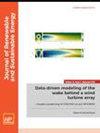Short-term multi-step forecasting of rooftop solar power generation using a combined data decomposition and deep learning model of EEMD-GRU
IF 1.9
4区 工程技术
Q4 ENERGY & FUELS
引用次数: 0
Abstract
In this study, an integrated forecasting model was developed by combining the ensemble empirical mode decomposition (EEMD) model and gated recurrent unit (GRU) neural network to accurately predict the rooftop solar power output at a specific power unit located in Tay Ninh province, Vietnam. The EEMD method was employed to decompose the solar power signals into multiple frequencies, allowing for a more comprehensive analysis. Subsequently, the GRU network, known for its ability to capture long-term dependencies, was utilized to forecast future values for each decomposition series. By merging the forecasted values obtained from the decomposition series, the final prediction for the solar power output was generated. To evaluate the efficacy of our proposed approach, a comparative analysis was undertaken against other forecasting models, including a single artificial neural network, long short-term memory network, and GRU, all of which solely considered the solar power series as input features. The experimental results provided compelling evidence of the superior performance of the EEMD-GRU model, especially when incorporating weather variables into the forecasting process, achieving the best results in all three forecasting scenarios (1-step, 2-step, and 3-step). For both forecasting targets, Inverter 155 and 156, the n-RMSE indices were 1.35%, 3.5%, and 4.8%, respectively, significantly lower than the compared single models. This integration of weather variables enhances the model's accuracy and reliability in predicting rooftop solar power output, establishing it as a valuable tool for efficient energy management in the region.使用 EEMD-GRU 的数据分解和深度学习组合模型对屋顶太阳能发电量进行短期多步骤预测
本研究结合集合经验模式分解(EEMD)模型和门控递归单元(GRU)神经网络,开发了一种综合预测模型,用于准确预测位于越南西宁省的一个特定发电单元的屋顶太阳能发电量。EEMD 方法可将太阳能信号分解为多个频率,从而进行更全面的分析。随后,利用以捕捉长期依赖性而著称的 GRU 网络来预测每个分解序列的未来值。通过合并从分解序列中获得的预测值,产生了太阳能输出的最终预测值。为了评估我们提出的方法的有效性,我们与其他预测模型进行了比较分析,包括单一人工神经网络、长期短期记忆网络和 GRU,所有这些模型都只将太阳能序列作为输入特征。实验结果有力地证明了 EEMD-GRU 模型的卓越性能,尤其是在将天气变量纳入预测过程时,在所有三种预测方案(1 步、2 步和 3 步)中都取得了最佳结果。对于逆变器 155 和 156 这两个预报目标,n-RMSE 指数分别为 1.35%、3.5% 和 4.8%,明显低于相比之下的单一模型。天气变量的整合提高了模型预测屋顶太阳能发电量的准确性和可靠性,使其成为该地区高效能源管理的重要工具。
本文章由计算机程序翻译,如有差异,请以英文原文为准。
求助全文
约1分钟内获得全文
求助全文
来源期刊

Journal of Renewable and Sustainable Energy
ENERGY & FUELS-ENERGY & FUELS
CiteScore
4.30
自引率
12.00%
发文量
122
审稿时长
4.2 months
期刊介绍:
The Journal of Renewable and Sustainable Energy (JRSE) is an interdisciplinary, peer-reviewed journal covering all areas of renewable and sustainable energy relevant to the physical science and engineering communities. The interdisciplinary approach of the publication ensures that the editors draw from researchers worldwide in a diverse range of fields.
Topics covered include:
Renewable energy economics and policy
Renewable energy resource assessment
Solar energy: photovoltaics, solar thermal energy, solar energy for fuels
Wind energy: wind farms, rotors and blades, on- and offshore wind conditions, aerodynamics, fluid dynamics
Bioenergy: biofuels, biomass conversion, artificial photosynthesis
Distributed energy generation: rooftop PV, distributed fuel cells, distributed wind, micro-hydrogen power generation
Power distribution & systems modeling: power electronics and controls, smart grid
Energy efficient buildings: smart windows, PV, wind, power management
Energy conversion: flexoelectric, piezoelectric, thermoelectric, other technologies
Energy storage: batteries, supercapacitors, hydrogen storage, other fuels
Fuel cells: proton exchange membrane cells, solid oxide cells, hybrid fuel cells, other
Marine and hydroelectric energy: dams, tides, waves, other
Transportation: alternative vehicle technologies, plug-in technologies, other
Geothermal energy
 求助内容:
求助内容: 应助结果提醒方式:
应助结果提醒方式:


